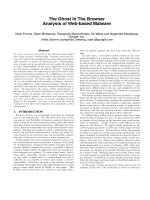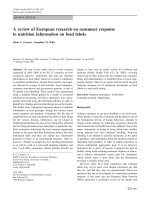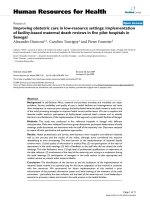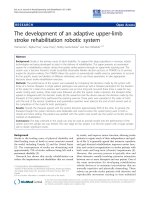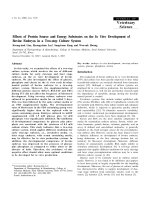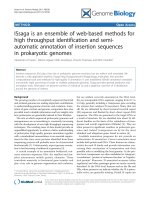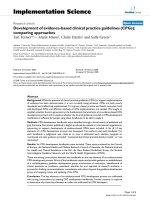Design and development of web based maternal and child nutrition information system
Bạn đang xem bản rút gọn của tài liệu. Xem và tải ngay bản đầy đủ của tài liệu tại đây (1.91 MB, 79 trang )
ADDIS ABABA UNIVERSITY
SCHOOL OF INFORMATION SCIENCE
AND SCHOOL OF PUBLIC HEALTH
M.sc in Health Informatics Program
Design and Development of Web Based
Maternal and Child Nutrition Information System
By: Tigist Habtamu
A Research Project Submitted to the School of Information Science and
Public Health for the Partial Fulfillment of the
Requirement for Degree of Master of Science in Health Informatics
June, 2017
Addis Ababa, Ethiopia
i|Page
ADDIS ABABA UNIVERSITY
SCHOOL OF INFORMATION SCIENCE
AND SCHOOL OF PUBLIC HEALTH
M.sc in Health Informatics Program
Design and Development of Web Based Maternal and
Child Nutrition Information System
By: Tigist Habtamu
Signed by the Examining Committee:
Advisor : Rahel Bekele (PhD)
Signature ______________ Date _____________
Advisor : Robel Yirgu (MPH)
Signature ______________ Date _____________
Examiner: Solomon Teferra (PhD)
Signature ______________ Date _____________
Examiner : Assefa Seme (PhD)
Signature ______________ Date _____________
ii | P a g e
Acknowledgment
I would like to express my gratitude and heartfelt thanks to my advisors Dr. Rahel Bekele and
Ato Robel Yirgu for their guidance and kindness throughout my thesis. I would also like to
convey my deepest gratefulness towards them for their advice and comment to accomplish this
research.
I also like to thank TEMAC project team for providing me relevant information and comment to
my project work.
I very cordially thank all of my friends. Especially Debre and Addis you were really friendly and
you make my stay in the university unforgettable.
Lastly, but not the least, my love and special thanks goes to my family. They are always
encouraging me and they have helped me stay strong.
Tigist
Addis Ababa, Ethiopia
i|Page
Table of Contents
Acknowledgment ........................................................................................................................................... i
Abbreviations and acronyms ........................................................................................................................ vi
Abstract ....................................................................................................................................................... vii
CHAPTER ONE ........................................................................................................................................... 1
INTRODUCTION ........................................................................................................................................ 1
1.1 Background ............................................................................................................................................. 1
1.2 Statement of the Problem ........................................................................................................................ 3
1.3 Objective ................................................................................................................................................. 6
General Objective ................................................................................................................................. 6
Specific objective .................................................................................................................................. 6
1.4 Scope and limitation of the project ......................................................................................................... 6
1.5 Significance of the project ...................................................................................................................... 7
1.6 Organization of the Document ................................................................................................................ 7
CHAPTER TWO .......................................................................................................................................... 8
LITERATURE REVIEW ............................................................................................................................. 8
2.1 Overview of Malnutrition ....................................................................................................................... 8
2.2 Cause of malnutrition .............................................................................................................................. 8
2.3 Maternal malnutrition ............................................................................................................................. 9
2.5 Malnutrition in Ethiopia ........................................................................................................................ 11
2.6 Intervention practices of malnutrition in the country ............................................................................ 12
2.6.1 Complementary Feeding ............................................................................................................ 13
2.6.2 Awareness creation plat forms ........................................................................................................... 14
2.7 Information Technology in Health Practice .......................................................................................... 15
2.7.1 Web Technology ........................................................................................................................ 16
2.8 Related work ......................................................................................................................................... 17
CHAPTER THREE .................................................................................................................................... 19
METHODOLOGY ..................................................................................................................................... 19
3.1 General approach .................................................................................................................................. 19
3.2 Study design .......................................................................................................................................... 19
3.3 Situational analysis ............................................................................................................................... 19
3.4 Study area.............................................................................................................................................. 20
3.5 Source population ................................................................................................................................. 20
3.6 Study population ................................................................................................................................... 20
3.7 Data collection instruments ................................................................................................................... 21
3.7.1 Interview .................................................................................................................................... 21
3.7.2 Document Review ...................................................................................................................... 21
ii | P a g e
3.8 Data analysis ......................................................................................................................................... 22
3.8.1 Tools .......................................................................................................................................... 23
3.9 Prototype design.................................................................................................................................... 24
3.10 Testing and evaluation ........................................................................................................................ 24
3.11 Ethical consideration ........................................................................................................................... 24
CHAPTER FOUR ....................................................................................................................................... 25
RESULT AND DISCUSSION ................................................................................................................... 25
4.1 Overview ............................................................................................................................................... 25
4.1.1 Demographic Information of mothers ................................................................................................ 25
4.1.2 Information access during pregnancy and lactating ........................................................................... 26
4.1.2.1 Information during pregnancy ........................................................................................................ 26
4.1.2.2 Information during Lactating .......................................................................................................... 27
4.1.3 Understanding of mothers about child feeding practice .................................................................... 27
4.1.3.1 Balanced diet ........................................................................................................................... 27
4.1.3.2 Complementary feeding .......................................................................................................... 28
4.1.4 Information technology access........................................................................................................... 28
4.1.5 Interview with health care provider ................................................................................................... 28
4.2 Discussion of Result ............................................................................................................................. 29
CHAPTER FIVE ........................................................................................................................................ 31
REQUIREMENT SPECIFICATION ......................................................................................................... 31
5.2 Functional Requirements ...................................................................................................................... 31
5.2 Non-functional Requirement................................................................................................................. 32
5.3 Analysis Model ..................................................................................................................................... 32
5.3.1 Use Case Diagram...................................................................................................................... 32
5.3.2 Use Case Model ......................................................................................................................... 33
5.3.3 Use Case Description ................................................................................................................. 34
5. 3.4 Activity diagram ....................................................................................................................... 37
5.3.5 Class Diagram ............................................................................................................................ 37
5.3.6 Deployment Diagram ................................................................................................................. 38
5.3.7 Prototype .................................................................................................................................... 40
CHAPTER SIX ........................................................................................................................................... 47
TESTING AND EVALUATION ............................................................................................................... 47
6.1 Testing .................................................................................................................................................. 47
6.2 Evaluation methods ............................................................................................................................... 48
6.2.1 Time to complete each task (minute and second) ...................................................................... 49
6.2.2 Average number of mouse clicks per task ................................................................................. 51
6.2.3 Post-test survey .......................................................................................................................... 51
iii | P a g e
CHAPTER SEVEN .................................................................................................................................... 54
CONCLUSIONS AND RECOMMENDATIONS ..................................................................................... 54
7.1 Conclusions ........................................................................................................................................... 54
7.2 Recommendations ................................................................................................................................. 55
Reference .................................................................................................................................................... 56
Annex .......................................................................................................................................................... 59
Information Sheet........................................................................................................................................ 59
Consent form ............................................................................................................................................... 61
Interview Guide .......................................................................................................................................... 63
Morea usability test questions ..................................................................................................................... 67
Morea observer screen shot ........................................................................................................................ 67
Morea survey question ................................................................................................................................ 68
iv | P a g e
List of Figure
Figure 1: use case diagram .......................................................................................................................... 33
Figure 2: Activity Diagram ......................................................................................................................... 37
Figure 3: Class Diagram ............................................................................................................................... 38
Figure 4 Deployment diagram .................................................................................................................... 39
Figure 5: home page.................................................................................................................................... 41
Figure 6 user interface to search and retrieval ............................................................................................ 42
Figure 7 : example of responsive site with landscape mode ...................................................................... 43
Figure 8 example of responsive site with portrait mode ............................................................................ 43
Figure 9: Maternal information page .......................................................................................................... 44
Figure 10: child Nutrition Information page ............................................................................................... 45
Figure 11: Complementary feeding information page ................................................................................ 45
Figure 12: Resource Page ........................................................................................................................... 46
Figure: 13 Average time to perform each task ............................................................................................ 50
Figure 14: Time taken to perform task by participant................................................................................. 50
Figure 15 : Average mouse click by task .................................................................................................... 51
List of Table
Table 1 : mothers educational background ................................................................................................. 25
Table 2 : Information source of mothers ..................................................................................................... 26
Table 3 : understanding of mothers about balanced diet............................................................................. 27
Table 4: Health education at the health center ............................................................................................ 29
Table 5: list of actors ................................................................................................................................... 32
Table 6: use cases ....................................................................................................................................... 33
Table 7 view use case description............................................................................................................... 34
Table 8: use case description to search information .................................................................................. 35
Table 9 : use case description to update web content ............................................................................... 36
Table 10: Expected task performance measure per time ........................................................................... 49
Table 11: Response summary of participants’ satisfaction ......................................................................... 52
Table 12 : User Satisfaction Survey ............................................................................................................ 52
v|Page
Abbreviations and acronyms
BMI Body Mass Index
CDC Center for Disease Prevention and Control
CMS Content Management System
CSS Cascading Style Sheet
EDHS Ethiopian Health and Demographic Survey
eHealth Electronic Health
ENI Ethiopian Nutrition Institute
EPHI Ethiopian Public Health Institute
FAO Food and Agricultural Organization
FMOH Federal Ministry of Health
FNIC Food and Nutrition Information Center
HAPCO HIV/AIDS Prevention and Control Office
HIV/AIDS Human immunodeficiency virus and Acquired
immune deficiency syndrome
ICT Information Communication Technology
IMNCI Integrated Management of Neonatal and childhood
illness
IT Information Technology
LBW Low Birth Weight
MCH Maternal and Child Health
MOH Ministry of Health
NNP National Nutrition Program
OO Object Oriented
PHP Hypertext Preprocessor
SDG Sustainable Development Goal
SQL Structured Query Language
STI Sexually Transmitted Infection
SUS Standard User Satisfaction
TB Tuberculosis
TEMACC Technology Enabled Maternal and Child healthcare
in Ethiopia
UML Unified Modeling Language
UNICEF United Nation Children Fund
WHO World Health Organization
WWW World Wide Web
vi | P a g e
Abstract
Under nutrition is one of the leading causes of morbidity and mortality of children in most
developing countries including Ethiopia. Maternal and child nutrition related issues are main
concerns of mothers, family or care takers, health care providers, organizations and governments
that work in the field of nutrition. Since nutritional information has significant role in the
reduction of maternal and child malnutrition, it is important to avail relevant nutritional data on
various media including the web to enhance the effort that the health sector is putting to reduce
maternal and child morbidity and mortality. Therefore, this study is intended to design and
develop web based maternal and child nutrition information system that give hands for the health
sector effort towards the reduction of maternal and child morbidity and mortality.
Interview and document analysis were used as main tools to capture the system requirement, and
the data was analyzed using inductive approach .The project used selected artifacts of an object
oriented system analysis and design technique to design the web based system.
The finding of the study shows that there is low level of awareness in the community about
maternal and child nutrition. The prime source of Information on nutrition during pregnancy and
lactation were not health professionals at the maternal and child health department, instead, they
get it from other pregnant women, family or friends. Therefore, availing information is one way
of intervention which strengthen the availability of information in a feasible and cost-effective
manner
vii | P a g e
viii | P a g e
CHAPTER ONE
INTRODUCTION
1.1 Background
Ethiopia is a country with great geographic diversity. About 84 percent of the total
population lives in rural areas, making the country one of the least urbanized country in the
world. As mentioned in the Health Sector Transformation Plan, the knowledge of population
about the value and preparation of disease preventing and body building foods such as vegetables
and fruits, and animal products is limited (1)(2) The cultural practices of the population towards
regularly feeding the family with these foods is not yet developed. The same is true with giving
complementary food to children as an addition to breast milk. The main contributor of the above
problems of malnutrition is not only low purchasing power of families, and inadequate supply of
food but the belief of the society about nutrition. As such, social and traditional pressures may
have a lot of contribution to the problem of malnutrition in Ethiopia. (3)(4) Social factors and
cultural practices in most countries have a very great influence on what people eat, on how they
prepare food, on their feeding practices and on the foods they prefer. Some traditional food
practices and taboos in some societies may contribute to nutritional deficiencies among particular
groups of the population.
WHO(5) defines Nutrition as the intake of food, considered in relation to the body’s
dietary need. Poor nutrition can lead to reduced immunity, increased susceptibility to disease,
impaired physical and mental development, and reduced productivity. Based on the Nutrition
Baseline Survey Report for the National Nutrition Program of Ethiopia; 2009/10(6)among
children 6-23 months of age and still breastfeed, 29 percent of children met the recommended
minimum dietary diversity (4 food groups per day), seventy-five percent of breastfed children
have received the minimum number of meals for their respective age. This is because of most
mothers do not have enough knowledge what to feed for their children(7) (8)
The Nutrition Baseline survey 2009/10 (6)also assesses nutritional status of mothers
during pregnancy and among the women respondents, during pregnancy 38 percent had eaten 12 food groups, 49 percent had eaten 3-4 and only 13 percent had eaten five or more food groups.
1|Page
The more schooling a woman had, the more likely she was to eat more food groups. Women
living in urban areas were also more likely to consume more food groups. Pregnancy-related
health and nutritional problems affect a woman’s quality of life, that of her newborn infant well
beyond delivery, and that of her family and community. As indicated by Blössner (9)
malnourished mother is likely to give birth to a low birth-weight (LBW) baby susceptible to
disease and premature death, which only further undermines the economic development of the
family and society, and continues the cycle of poverty and malnutrition.
According to UNICEF report (10)malnutrition is also an issue with children. Nutritional
status of under-five children is an important outcome measure of children’s health. Research
shows that the level of resistance to infection is lower for malnourished children than other
children, causing high levels of morbidity and mortality .Further, poor nutrition also affects the
cognitive development of children.
Generally, malnutrition in both mothers and children remains one of the health challenges
that Ethiopia has to deal with to remain on course to achieve the health-related Sustainable
Development Goals (SDGs). (11) Reducing malnutrition does not only benefit maternal and
child health and development, it also promotes the future, long-term growth and economic
progress of the nation. Because there are strong synergies between health and nutrition that are
well-documented; good health is not possible without good nutrition .According to UN 2014
report (12) being malnourished in any form carries significant risks to health. Resolving all
forms of under nutrition and obesity would dramatically reduce the social burden of sickness and
premature death, and the economic burdens of lost productivity and contribute to improving
healthy lives and wellbeing for all.
There are lots of efforts to address the issue of malnutrition. Researchers do different
surveys and assessment to know the available food sources in different regions of the country. In
addition they study nutrition requirement for pregnant woman, child daily food intake, and
nutritional value (content) of foods and how to prepare complementary foods based on the age
groups(like complementary recipe book by ENI). But the preliminary survey indicates that the
findings are not easily accessible to mothers and care givers because materials are kept in health
related organizations in the form of hard copy so the public have no access for those documents.
2|Page
To this end, it is important to avail the materials to the general public using ICT.
According to Mengesha (13) ICT is a key area for improving service delivery, promoting easier
information exchange. ICT is a cross cutting area which supports all function and operation areas
by facilitating the automation of various processes. The Federal Ministry of Health (FMOH)(1)
has recognized the benefits of Information and Communication Technology (ICT) as a tool to
support the health sector and set it as a transformation agenda. Coincidentally the Ethio-telecom
has upgraded its network service to enable clients to be the beneficiaries of a modern and
efficient’ service, which enable clients to get a fast internet connection. According to Internet
world statistics (14) in Ethiopia internet users in the year 2000 were 10,000 but in the year 2017
the number of internet user developed to 11,538,000 and the number of Facebook users become
4,500,000.
Research on ICT brief shows that (15) 67% of Ethiopians Internet users first use the
Internet on a mobile phone , while the first wave of Internet adoption rode on the back of desktop
computers at the work place, schools and universities or public access facilities such as Internet
Cafes, the second wave is sweeping across Africa through the use of mobile phones.
Therefore, this project is one of a kind to contribute to solutions related to malnutrition
using the above mentioned opportunities. It specifically makes attempt to use web based
technology. Web-based applications provide flexible and easy access of information. The reason
for the Web success is largely due to its simplicity for use and information retrieval. (16)Webbased technology platforms allow integrated delivery of desired services to users with the right
time and privileges. So this web based system for maternal and child nutrition information
system is designed to support the effort to decrease maternal and child mortality. The WWW
enhances human cognition, communication, and co-operation.
1.2 Statement of the Problem
Nutritional status is an outcome and impact indicator when assessing progress towards
achieving the Sustainable Development Goals (SDG). Child nutritional status is related with
SDG special Target 3.2. As malnutrition is a frequent cause of death for newborns and underfive children, the SDG aims to end all forms of malnutrition by 2030.
3|Page
It is indicated in EDHS (17) Ethiopia has the second highest rate of malnutrition in SubSaharan Africa where women and children are the main victims of the problem. Poor maternal
nutrition during pregnancy harms the health of the child in the womb with continued negative
consequence of the child throughout life. Study by World Bank (18) indicates that
if
malnutrition is left untreated during the first two years of life, this damage can be irreversible
and can cause lower intelligence and reduced physical capacity. These conditions in turn, reduce
productivity, slow economic growth and are responsible for poverty amongst a population. Also
(9) maternal under nutrition is considered to be the risk factor for neonatal deaths.
Similarly, the nutrition extension package, which is a subcomponent of the 16 Health
extension packages (19) indicate that although Ethiopia is a producer of a variety of agricultural
products, it is nevertheless, one of the countries in the world with the highest number of
malnourished population. It is also mentioned that the health problem of the majority of the
population of Ethiopia emanates from lack of adequate and balanced diet. It is also indicated
children, pregnant women and lactating mothers are most affected by the problem.
Illiteracy and poverty may also influence the food intake of people in the
community
and become causes of malnutrition. Nutrition knowledge for lactating mothers is one key factor
that determines the health and wellbeing of mothers and infants. If mothers have good
Nutritional information, it is easy to understand different types of food, how food nourishes the
body and powers health. According to Temesgen (20), Lactating mothers from low-income
countries including Ethiopia are considered as a nutritionally vulnerable group due to different
socio demographic factors and lack of nutritional knowledge which impact on the health and
well-being of children.
What is more, mother and care givers have very limited information about maternal and
child nutrition. They don’t have enough information how to enrich complementary foods by
adding vegetables or animal products, because of this the child couldn’t get adequate nutrition
and become malnourished. Furthermore, it is not easy for literate mothers to find information
about child feeding practices, because materials in the country are not easily accessible.
In order to address such problems the FMOH developed family centered nutrition package.
(19)Amongst the major objectives were to develop the knowledge and skills of the society about
4|Page
nutrition and to build its capacity for identifying and taking appropriate actions to eradicate
malnutrition and prevent its recurrence; enable/capacitate the society to have adequate concept/
knowledge about the essence and value of nutrition; empower the society to understand the
nutritional care that mothers and children require and create capacity to the implementation of
the nutrition package. However, the available materials have limited circulation, mainly used by
the health extension workers.
This project made an attempt to enable mothers and health professionals get basic maternal
and child nutrition information using web based application. From the foregoing, it is understood
that nutritional information plays a significant role in reducing maternal and child malnutrition.
FAO report shows that (21) there is ample evidence that improving food security alone does not
necessarily improve dietary diversity or child nutritional status. On the other hand, nutritional
status can be improved through nutrition education even in the absence of improvements in food
security.
FAO recommends nutrition information to be provided (21) through different channels:
Integrating nutrition education into health sector and school are actively promoting use of food,
particularly local foods to improve nutritional status of women and children in addition using
mass media can broadcast nutrition education beyond the print media . Web based application is
also an alternative system proposed to alleviate these problems. (16)Web-based technology
platforms allow integrated delivery of desired services to users with the right time and privileges.
According to world wide web foundation (22) the use of web-based application are
It can be accessed from the personal computer or mobile phone;
People become familiar using the Web to get the news, weather forecasts, cooking
recipes, medical information, social media and the like.
Information linked to social media can be transferred fast and can address multiple
individuals at a time.
It is cheap and efficient means of communication
Therefore the aim of this project is to assess materials available in maternal and child
nutrition program to develop a web based maternal and child nutrition information system in a
local language (Amharic) which enables mothers, care givers, health professionals and others to
5|Page
get basic information on nutrition during pregnancy, lactating and complementary food content
and preparation. The main goal of providing nutritional information is to make people aware of
what constitutes a healthy diet and ways to improve their diets and their lifestyles.
1.3 Objective
General Objective
The general objective of this project is to design and develop web based Maternal and Child
Nutrition information system to be used by mothers, health profesionals ,caregivers and others .
Specific objective
To identify Information seeking behavior of mothers
To specify requirements from potential users
To develop content in consultation with relevant experts
To design appropriate user interfaces in Amharic language
To develop a prototype web based application
To test usability of the prototype
1.4 Scope and limitation of the project
The scope of the project is to design and develop web based Maternal and Child Nutrition
Information System. It is designed to provide information only on nutrition during pregnancy,
childbirth, and the postpartum period. The content of the web was collected from governmental
and non governmentnal institutions working on the area of maternal and child nutrition , and also
by consulting experts in the field .
The project has limitation to accommodate all available infant recipes of time constraint.
6|Page
1.5 Significance of the project
This web based maternal and child information system will assist the community for
better understanding of the nutritional value of food they provide for pregnant mothers and their
infants. It also enables mothers, care givers, health professionals and others who have similar
interests to find basic information on maternal and child nutrition. The system help them to make
healthy food choices on available food sources in their environment and introduce measurement
and preparation of complementary foods for their infant.
Mothers, care givers and infants are direct beneficiaries of the system, moreover this
Web-based system help health professionals to access information which is relevant during MCH
consultation.
As such the lack of information regarding what to eat &how to eat during
pregnancy and early childhood is addressed in this research for the advantage of mothers and
children.
1.6 Organization of the Document
The thesis is organized as follows: Chapter one is the introduction part and it covers the
background, the statement of the problem, objectives, significance of the project and scope of the
project. Chapter two deals with the literature review. Chapter three presents the methodology
used in carrying of the project. Chapter four is findings of the survey on information seeking
behavior of mothers. Chapter five is requirement specifications, system analysis and modeling.
It also talks about the design and development of the proposed system. While chapter six
presents testing and evaluation chapter seven is conclusion and recommendation.
7|Page
CHAPTER TWO
LITERATURE REVIEW
2.1 Overview of Malnutrition
Malnutrition is a condition that results from eating a diet in which nutrients are either not
enough or are too much such that the diet causes health problems. According to UNICEF
definition (23) Malnutrition is a term that includes over nutrition and under nutrition. Over
nutrition results from too much nutrient intake relative to nutrient requirements based on age,
gender, physical activity, height, weight, and health status of the individual; which is rare in
Ethiopia. And under nutrition describes a range of conditions including being underweight,
being short, being thin and being deficient in vitamins and minerals.
On the other hand Save the Children report (24) stresses that the magnitude of
malnutrition as a silent killer – under-reported, under-addressed and, as a result, underprioritized. Malnutrition-related deaths are often put down to the disease that the child eventually
died from. According to the report every hour of every day, 300 children die because of
malnutrition.
2.2 Cause of malnutrition
Under nutrition is caused by many different factors that often interact with one another.
UNICEF conceptual framework for under nutrition, developed in the 1990s(25) provides a clear
depiction of the various factors associated with under nutrition and the distinct levels at which
these factors act. In the framework, the causes of under nutrition are divided into three levels:
immediate, underlying and basic
Immediate causes (individual level): Inadequate food intake and disease are immediate
causes of under nutrition. These operate at the individual level.
8|Page
Underlying causes (household and community level): Household food security, social
care for mothers and children, and the health environment and access to health services are
underlying causes that contribute to under nutrition.
Basic causes (sub-national, national and international level): Political, cultural, financial
and environmental factors also contribute to under nutrition at the basic level.
On the other hand illiteracy and poverty also influence the food intake of people in the
community and become causes of malnutrition.(24)the educational status of women is a key
underlying factor in maternal and child feeding practices, and in child malnutrition.
2.3 Maternal malnutrition
A mother’s nutritional status, (26) diet and lifestyle influence pregnancy and lactation
outcomes and can have lasting effects on her offspring’s health. Inadequate intakes of certain
micronutrients during pregnancy, such as folic acid and iodine, can contribute to birth defects
and/or the inability of the child to develop to his or her full cognitive potential.
Besides Mora and Nestel study shows (27) some 200 million women become pregnant
each year, most of them in developing countries . Many of these women suffer from both
ongoing nutritional deficiencies and the long-term cumulative consequences of under nutrition
during childhood. Pregnancy-related health and nutritional problems affect a woman’s quality of
life, that of her newborn infant well beyond delivery, and that of her family and community.(9)
A malnourished mother is likely to give birth to a low birth-weight (LBW) baby susceptible to
disease and premature death, which only further undermines the economic development of the
family and society, and continues the cycle of poverty and malnutrition.
Although Monika and Mercedes states(9)The nutritional status of women and children is
particularly important, because it is through women and their off-spring that the pernicious
effects of malnutrition are propagated to future generations. A malnourished mother is likely to
give birth to a low- birth-weight (LBW) baby susceptible to disease and premature death, which
9|Page
only further undermines the economic development of the family and society, and continues the
cycle of poverty and malnutrition.
It is described in Linkage maternal nutrition manuals that (28) During pregnancy all
women need more food, a varied diet, and micronutrient supplements. When energy and other
nutrient intake does not increase, the body’s own reserves are used, leaving a pregnant woman
weakened. Pregnant women also require more protein, iron, iodine, vitamin A, folate, and other
nutrients. Deficiencies of certain nutrients are associated with maternal complications and death,
fetal and newborn death, birth defects, and decreased physical and mental potential of the child.
Linkage manual also indicate that lactation places high demands on maternal stores of energy,
protein, and other nutrients. These stores need to be established, conserved, and replenished. The
energy, protein, and other nutrients in breastmilk come from a mother’s diet or her own body
stores. Women who do not get enough energy and nutrients in their diets risk maternal
weakening. To prevent this, extra food must be made available to the mother. Breastfeeding also
increases the mother’s need for water, so it is important that she drinks enough to satisfy her
thirst. Maternal deficiencies of some micronutrients can affect the quality of breastmilk. These
deficiencies can be avoided if the mother improves her diet before, during, and between cycles of
pregnancy and lactation.
Therefore, it is essential to inform the community that(29)Pregnancy is a critical time of
human development, and anything that compromises the fetal environment may have important
and lasting effects on the child’s future health. It is important as a society to prioritize helping
women understand the impact that their life-style choices have on their children. Maximizing the
health of the pregnant mother will ensure her child the best start at life possible.
2.4 Child malnutrition
Blössner Mstudy shows (9)Malnutrition commonly affects all groups in a community, but
infants and young children are the most vulnerable because of their high nutritional requirements
for growth and development. According to global nutrition report (30) Malnutrition manifests
itself as children who do not grow and develop to their full potential .On the other hand (10)
nutritional status of under-five children is an important outcome measure of children’s health .
10 | P a g e
Research shows that the level of resistance to infection is lower for malnourished children than
other children, causing high levels of morbidity and mortality (UNICEF 2001). Further, poor
nutrition also affects the cognitive development of children
As indicated in the Save children report (24) the world has enough food for everyone, so
putting an end to the hunger and malnutrition crisis is the right thing to do. Every child has the
right to a life free from hunger. No child should be born to die from a cycle of malnutrition and
disease because they are not able to eat enough nutritious food
2.5 Malnutrition in Ethiopia
Under nutrition is a major public health problem in Ethiopia. (31) About five million
people experience food shortages each year, and approximately 2.9 million people were expected
to receive food assistance in 2015. According to Goal (17)malnutrition is the underlying cause of
57% of child deaths in Ethiopia, with some of the highest rates of stunting and underweight in
the world. As for women in the country, over a quarter had a low body mass index (BMI)
(<18.5) in 2005.
Based on the Nutrition Baseline Survey Report for the National Nutrition Program of
Ethiopia; 2009/10(6), most mothers do not have enough knowledge what to feed for their infant
and children. The result of the national nutrition survey 2009/10 indicate that, among children 623 months of age and still breastfeed, 29 percent of children met the recommended minimum
dietary diversity (4 food groups per day), seventy five percent of breastfed children have
received the minimum number of meals for their respective age. It is also mentioned in the
Health Sector Transformation Plan, the knowledge of population about the value and preparation
of disease preventing and body building foods such as vegetables and fruits, and animal products
is limited(1) The cultural practice of the population towards regularly feeding the family with
these foods is not yet developed. The same is true with giving complementary food to children as
an addition to breast milk. The main contributor of the above problems of malnutrition is not
only low purchasing power of families, and inadequate supply of food but the belief and the
concept of the society about nutrition.
11 | P a g e
As such, social and traditional pressures may have a lot of contribution to the problem of
malnutrition in Ethiopia. As Zerfu states (32)number of taboos related to the intake of certain
food items and misconceptions that can adversely affect nutritional status during pregnancy. The
most common taboos were related to the consumption of green leafy vegetables, yogurt, cheese,
sugar cane, and green pepper. However, the frequency and extent of the practice varied by
maternal age, family composition, and literacy level. Older mothers and those with no formal
education were more likely to practice the taboos than younger and educated ones. Mothers
disfavored weight gain during pregnancy in fear of obstetric complications associated with the
delivery of a bigger infant.
2.6 Intervention practices of malnutrition in the country
National Nutrition program stresses (33)to life cycle nutritional intervention with greater
emphasis and focus on the crucial period of pregnancy and the first 2 years of life - the 1000
days from conception to a child’s second birthday during which good nutrition and healthy
growth have lasting benefits throughout life.
Likewise, Global Nutrition report indicates(30)in 2015 Ethiopian government’s
commitment to redesign the largest social protection program in Africa to make it more nutrition
focused. Combating malnutrition is the best development investment.(24) Investing in nutrition
is investing in the future of a country; it creates stronger communities with a healthier, smarter
and more productive population. Besides(30)in Ethiopia, the health extension system is taking
on the delivery of nutrition interventions like infant feeding counseling and calcium
supplementation. Because improving children’s nutrition also leads to wider social and economic
gains.
According to global nutrition report to address a problem of malnutrition (30) it is
important to be supported by an informed and empowered civil society.(24)promoting the best
foods and best ways to feed children between the ages of 6 to 24 months is one way of
malnutrition intervention.
It is important to promote maternal and child nutrition , (34)such as focusing on the 1,000-day
window, immediate and exclusive breastfeeding, complementary feeding, and food fortification
and supplementation. It is also important to explore new approaches, such as improving nutrition
12 | P a g e
for women and adolescent girls, increasing advocacy and technical assistance, improving data
systems. It is also important to enhance nutrition education with IT because (35)effective use of
information technologies has become a critical success factor in modern society. Likewise ICT
is a cross-cutting enabler to address the all-around nature of nutrition by improving access to
healthy diets and improving knowledge for food choices, (30) when information is provided to
mothers, the challenges are no longer barriers.
2.6.1 Complementary Feeding
Complementary feeding means giving other foods in addition to breast milk starting
when an infant is 6 months old since at this time breast milk alone is not sufficient to meet a
growing infant’s nutritional needs. Complementary foods are needed to fill the calorie, protein
and micronutrient gap between the total nutritional needs of the child and the amount provided
by breast milk. FAO report define complementary feeding as (36)the period of transition from
exclusive breastfeeding to family foods, referred to as complementary feeding, covers a child
from 6-23 months of age, and is a very vulnerable period. It is the time when malnutrition starts
in many infants, contributing to the high prevalence of malnutrition in children under two years
of age. The report also indicate. The report also states that malnutrition in young children can be
prevented by feeding them enough nutritious and safe complementary foods. Good
complementary feeding means feeding your child enriched food every day and offer additional
nutritious snacks between meals. You can prepare good enriched food from a variety of local
foods that are available in your home, from your garden or the local market.
According to Alive and Thrive complementary feeding in-service training manual (37)
most often, malnutrition during infancy starts when children transition from nutritious breast
milk to thin cereal or starch-based gruel (atmit) usually fed in bottles, which can result in
complications and diarrheal diseases. Traditional infant foods are thin gruels made of cereals that
are very low in energy and the micronutrients needed to promote physical and cognitive
development. Furthermore, the bulkiness of traditional infant foods and the concentration of
fibers and inhibitors in staple food crops are major factors in reducing nutritional benefits of
complementary foods. These foods fill the child’s stomach but they do not provide enough
energy and nutrients for good physical growth and mental development, often resulting in
13 | P a g e
malnutrition. Ideally, complementary foods should contain animal-source foods such as meat,
chicken or eggs which have high biological value, foster growth and development and combat
stunting, especially during the first two years of life. However, these foods are not fed to infants
and young children due to various misconceptions and traditional beliefs in the country.
Moreover statistics indicate that(1) among children older than 6 months only 4.3% of children in
this age group consumed the requisite four food groups. Only 13% of children under age of two
years consumed iron rich food.
2.6.2 Awareness creation plat forms
In 1986 EC the Ethiopian Nutrition Institute (ENI) publish complementary feeding
booklet and distribute for the health institutes as a teaching guide. The major objective of this
booklet was to improve the low level of awareness of nutrition in the society, because it is the
major cause of malnutrition in the county. In addition this booklet introduces the basic principles
of nutrition and how to prepare and feed children using available food sources at home. The
complementary food preparations booklet designed by considering major food sources in
different regions of the country. The assessment was done what food sources are available and
used in different part of the country, and identifies that the southern part of Ethiopia uses Enset
and corn and the northern and central part of Ethiopia uses Teff, wheat and sorghum as a major
source of food. Based on the assessment the complementary food preparation was developed.
On the other hand Linkage –Ethiopia in collaboration with the Federal Ministry of Health
of Ethiopia prepare a guide book in August 2006 entitled, “Complementary Feeding Recipes for
Ethiopian Children 6-23 Months Old. A Practical Cooking and Feeding Guide”. The purpose of
this book was to provide service providers with information necessary for counseling mothers
and child caretakers on how to feed their children 6-23 months, specifically on aspects of
complementary feeding in addition to continued breast feeding. The book contains simple
nutritious complementary feeding recipes that can be prepared from locally available foods for
three major staple eating areas of the country, including (1) maize/enset/teff, (2) wheat/barley,
and (3) sorghum/maize. The recipes have been developed to meet the changing nutritional needs
of children in two age groups, 6-11 months and 12-23 months, in terms of calories, consistency
and thickness. These amounts conform to the recommendations contained in the internationally
14 | P a g e
accepted Guiding Principles on the Complementary Feeding of the Breastfed Child (PAHO
2002) as well as take into account the adaptation of these principles by the Federal Ministry of
Health in Ethiopia
Alive & Thrive an initiative funded by the Bill & Melinda Gates Foundation and the
governments of Canada and Ireland, start to demonstrate innovative approaches to improving
feeding practices with three countries namely Bangladesh, Ethiopia, and Viet Nam in 2009 with
the objective of to save lives, prevent illness, and ensure healthy growth and development
through improved breastfeeding and complementary feeding practices and to promote good
nutrition in the first 1,000 days, from conception to two years of age, is critical to enable all
children to lead healthier and more productive lives. This initative develop materials
to encourage families to take action and monitor their personal progress in
adopting the 7 excellent feeding actions by using a checklist,
tool for health professionals for counseling on seven excellent feeding actions in
Ethiopia in 4 languages (English , Amharic, Oromifa and Tigrigna ) ,
Provides frontline workers with a tool for counseling on age-appropriate feeding
practices, from birth through the first 24 months.
And also produce a TV spot on complementary feeding during sickness and
thickness of complementary foods.
FMOH health extension nutrition package (19) is prepared to develop the knowledge and
skills of the society about nutrition and to build its capacity for identifying and taking
appropriate actions to eradicate malnutrition and prevent its reappearance. The health extension
workers will be the implementers of the package.
2.7 Information Technology in Health Practice
As Wilson states (17) Information and Communication Technology applications are
useful in numerous instances to facilitate the developments of various aspects of the society, it is
considered as an enabler for various disciplines. It is applied in different areas and witnessed an
effective result. Such as improving the quality of life for citizens in health and education plus
sharing knowledge and improving access to information. States
15 | P a g e
